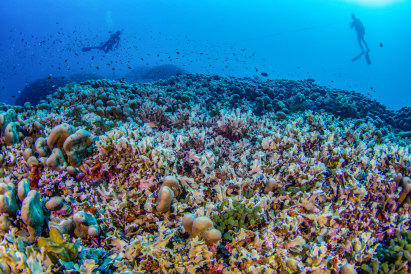
When scientists first saw the dark shape in waters off the Three Sisters island group in Makira-Ulawa Province of the Solomon Islands, they thought they’d found a shipwreck.
Instead, they’d stumbled upon a colossus unmatched anywhere in the world. When underwater cinematographer Manu San Felix dove into the clear water for a closer look, he discovered the shadow the team could see from their boat was a world-beating mega-coral, Pavona clavus.

Divers from National Geographic’s Pristine Seas team measure the world’s largest coral colony in the Solomon Islands.Credit: Manu San Félix/National Geographic
Measuring 34 metres long by 32 metres wide and standing 5.5 metres high, the coral is the largest in the world. It is so colossal, researchers say, it is visible from space and would take up the space of five tennis courts.
The National Geographic Pristine Seas team, which discovered the mammoth organism, believes it to be between 300 and 500 years old.
In contrast to coral reefs, which are networks of coral colonies, the Solomon Islands coral is a single structure, comprised of millions of coral polyps acting in accord.
“Just when we think there is nothing left to discover on planet Earth, we find a massive coral made of nearly one billion little polyps, pulsing with life and colour,” said National Geographic explorer-in-residence Enric Sala, the founder of Pristine Seas.

The gigantic organism is a complex network of coral polyps — tiny individual creatures — that have grown over a span of three centuries.Credit: Inigo San Félix/National Geographic
“This is a significant scientific discovery, like finding the world’s tallest tree. But there is cause for alarm. Despite its remote location, this coral is not safe from global warming and other human threats.”
The coral, which is mostly brown but scattered with splashes of bright yellows, blues and reds, is a haven for juvenile reef fish, crabs and other reef invertebrates.



























